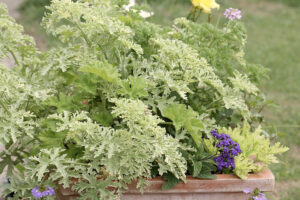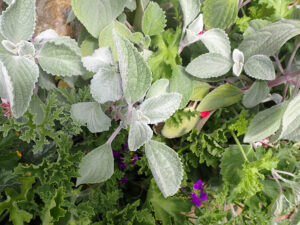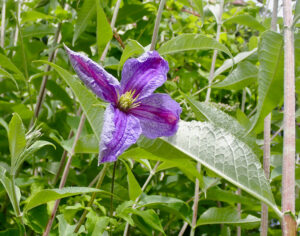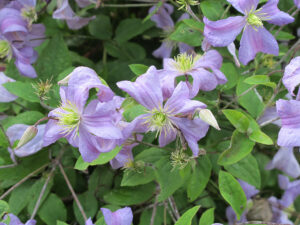It’s one of the joys of having your own greenhouse. You can use it to propagate your own plants. You might think it’s all about saving money and, in these straitened times, that’s a definite consideration. However, raising plants from cuttings is far more than a financial matter. There’s a certain excitement and satisfaction to raising your own ‘babies’, whether it’s watching your seeds burst into life, or turning a cutting into a viable plant. And you’ll always have plants to share with your friends.

Summer is the perfect time to take semi-ripe cuttings from all sorts of tender-ish plants including penstemons, salvias, fuchsias, heliotrope and pelargoniums. The cutting material must be firm and pliable, so it will have matured from soft and very young to slightly rubbery and firmer. When taking most cuttings of slightly tender plants (whether it’s penstemons, salvias, plectranthus or pelargoniums) you need to look for side shoots about two or three inches in length. Plectranthus are coleus relatives from Australia and the best one, for a mixed tub of pelargoniums, is the silvery Plectranthus argentatus.
Prepare your cuttings well. Take off the lower leaves and trim your cutting just below the node, that’s the bumpy joint where the leaves emerge from the stem. A sharp and clean cutting knife or scalpel is ideal. Remove any flower buds, so your cutting concentrates its energy in putting roots down rather than flowering. Trim any over large leaves by half, to prevent too much transpiration.
Now that you’ve prepared your cutting, plunge it into gritty horticultural sand, not fine sand, or a 50% mixture of gritty sand and compost. The biggest mistake people make is not putting the cutting in deeply enough. You can use small pots or small rigid plastic seed trays. Make sure the cutting is plunged in deeply. It needs to have at least a third to a half of its stem put into the growing media of the pot or tray.

Cover with a poly bag, for a few days, and then find a shady pot in your greenhouse. Keep the sand moist and this is why fine sand is no good for cuttings. It doesn’t hold moisture nearly well enough. It needs to be gritty! In summer, these semi-ripe cuttings will root in a few weeks. Once August arrives, they slow down so you may have to wait until February. A gentle tug – after a few weeks – will indicate whether your cutting has rooted or not. Pot them into small 9cm pots.
Pinks and carnations are treated differently. They are pulled away from the stem, so that they have a sliver of stem known as a heel. This exposes the cambium layer and helps them to root more quickly. You don’t generally need rooting compound for semi-ripe tender-ish cuttings. Although you may want to invest in some for hydrangeas. However, It has a short shelf life.

I like to raise some clematis plants every year and there’s a different strategy with these, because they are raised from internodal cuttings. This means that lengths of pliable stem are cut away from the clematis – preferably in early summer. These stems can be two or three feet in length. Cut off the top growth, because it’s too soft to root. Prepare to cut it into sections. Make a cut above a leaf joint and take off the leaves. Make another cut in the stem – a couple of inches above a lower node. The average cutting id three to four inches in length. Nick the side of the cutting, at the bottom, to damage it: the wound will expose the cambium layer.
After trimming, put the cutting straight into water to prevent it wilting and then then poke your hydrated cuttings into a mixture of 50%compost and 50% grit. Put several in a pot. Poking them in helps to scar the stems, so they’re more likely to root. Add a layer of horticultural sand to keep the moisture in, but don’t bag your clematis cuttings up. It will encourage botrytis.
You can use rooting compound, because they are slower to root. Cuttings generally take several weeks to put out some roots on. Once rooted, individual cuttings should go into clean, small 9cm pots at first. No heat is needed for cuttings taken in June and early July.

‘Viticella’ clematis are my personal favourites, because they bear lots of small flowers in July, after the rush of June roses and perennials have faded. Their name means small vine and they scramble very lightly though things. Hence, they make great follow up acts with rambling roses, which generally flower once in June. The combination of the apricot rambling rose ‘Goldfinch’ and the deep-purple ‘Etoile Violette’ works really well and they overlap slightly in most years. The dark-purple flowers usually have six tepals, each separated by a wide gap, surrounding cream-yellow stamens.
‘Etoile Violette’ is probably the most well-regarded viticella clematis of all and it was once voted the favourite clematis by the Clematis Society. It’s been around for 140 years and it was raised in France by Morel in 1885. I used to have it scrambling through a silver-leaved weeping pear which I’d trimmed into a mophead. A vision of grey-green and purple. ‘Polish Spirit’ is similar but flowers later.
Viticella clematis, which have (Vt) after their varietal name, are very drought-tolerant once established. This is because this species grows naturally in drier parts of Spain and southern Europe. Consequently, viticellas don’t suffer from wilt in dry conditions, as larger-flowered clematis do and can. In fact, the species has been thriving here since 1569 and it was called the “virgin’s bower” in honour of Elizabeth I. The species has dark-blue bells, but clematis breeders have produced a full range of colours and flower shapes.

One of the oldest known viticellas is ‘Purpurea Plena Elegans’, which is a clover-red double with long-lasting flowers. It was reputedly grown before 1629, when Charles 1st was on the throne and was thought to have been lost to cultivation. It was rediscovered growing at Abbotswood, in Gloucestershire by the late Graham Stuart Thomas in the 1960s. There is another heritage double, with deep-blue flowers, which is sold under two names, ‘Mary Rose’ and ‘Flore Pleno’. It may be even older than PPE.
The first wild gardener, William Robinson (1838-1935) of Gravetye Manor in Sussex, grew many viticella clematis and described them as having a “wonderful fertility of flowers. . . . which are successively and continuously renewed.” He allowed them to scramble over the ground as well as climb.
‘Betty Corning’ has viticella blood, but her frilly, fragrant blue-grey flowers have a touch of warm pink. This American clematis was discovered by Betty Corning, who aas married to the Mayor of Albany. She had spotted this clematis in 1933, in a downtown area, and she took her mother to see it. Mrs Platt realised that it was very unusual and they knocked on the door and the house owner dug up a piece of the plant. Shortly afterwards the house was bulldozed.

If you want a less vigorous one, ‘Royal Velours’ has wine-red, velvet-textured rounded flowers. Others have asymmetrical flowers with hints of green on the tepal. The white-flowered ‘Alba Luxurians’ looks wonderful in light shade, with its wispy green and white flowers. ‘Madame Julia Correvon’ has dark buds that open to produce twisted wine-red flowers with ruched, narrow petals which gently recurve. The lime-yellow stamens are informally arranged and the mixture of different flower shapes – from four-tepalled to six – adds to the charm. It grows well in shadier conditions and is free-flowering from early July. This was also bred in France by Morel, in about 1900, and was rediscovered growing at Hidcote.
The other lovely thing about all viticellas is that they are easy to prune. The optimum time is around Valentine’s Day, although the weather must be clement. Never prune anything in severely cold weather. Cut the stems back hard to the emerging buds, ideally about a foot from the ground. Pull away the old stems. All clematis need well-drained soil and a cool root run. Finally, all are best planted in the autumn, although container-grown plants can be planted throughout the year – as long as they are well-watered.



